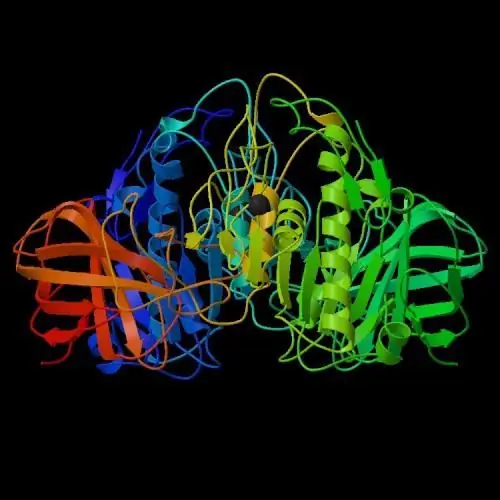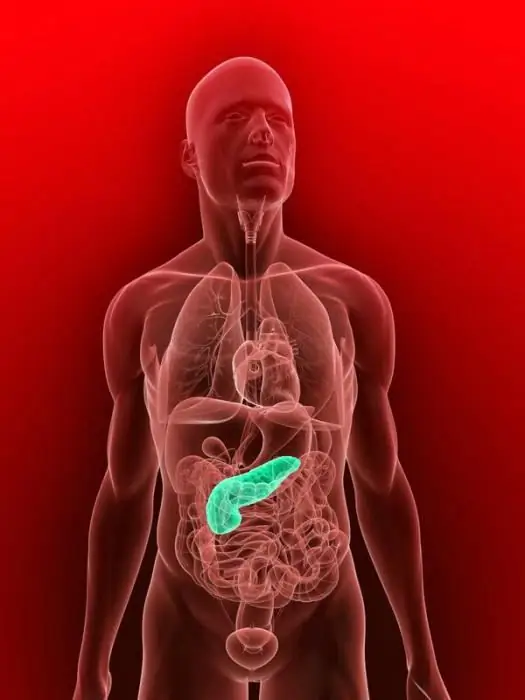- Author Curtis Blomfield [email protected].
- Public 2023-12-16 20:44.
- Last modified 2025-01-23 17:01.
Lipase is a water-soluble enzyme synthesized by the human body. It catalyzes the hydrolysis of insoluble esters and also helps neutral fats to be digested, dissolved and fractionated.
Main function
The enzyme lipase, together with bile, aids in the digestion of fats as well as fatty acids. It is involved in the processing of fat-soluble vitamins A, E, D, K and transforms them into heat and energy.

Lipase in the blood breaks down triglycerides (lipids). This delivers fatty acids directly to body tissues.
Which organs produce lipase
In the human body, the enzyme lipase is produced:
- in the pancreas;
- in the liver;
- in the lungs;
- in the intestines.
In addition, the enzyme is produced in infants in the oral cavity due to special glands. In babies, lingual lipase is synthesized, which acts on milk fats.
Each organ supplies a specific enzyme that breaks down strictly defined groups of fats.
Purpose of lipase in the human body
Sothe main mission of any type of lipase is the processing of fats, their splitting and fractionation. Also, this substance is actively involved in the exchange of energy, promotes the absorption of polyunsaturated fatty acids, certain vitamins.
The most important enzyme is produced by the pancreas. Pancreatic lipase is an enzyme by which lipids are absorbed completely and fully. It enters the digestive tract, where, under the influence of colipase, which is also a pancreatic enzyme, it combines with bile acids and is converted into an active form. Pancreatic lipase performs an important role - it breaks down triglycerides (neutral fats) into two components: glycerol and higher fatty acids.
Differences between different types of lipase
As noted above, different types of lipase interact with certain types of fats.
Lepatic lipase works with low density lipoproteins. It is she who acts as a regulator of plasma lipids.

Gastric lipase actively breaks down oil tributyrin. Lingual is involved in the breakdown of fats contained in breast milk.
Norm and deviation
By the level of how much lipase is present in the blood, one can judge the state of the human body. Deviations in the direction of increase or decrease allow physicians to determine diseases associated with the gastrointestinal tract. Therefore, when complaining of ailments, doctors prescribe a general analysis. Lipase - what is it: norm or deviation? There are certain general criteria.
- In adults, regardless of gender, who are 17 years old, the lipase index per 1 milliliter of blood should be from 0 to 190 units.
- For children and adolescents, this indicator is slightly lower and should normally fall within the range from 0 to 130 units.
- If the level of pancreatic lipase is examined, then the norm will be 13-60 units of the enzyme per 1 ml of blood. Anything above these indicators indicates a malfunction in the body.
If the indicators exceed the norm
If lipase is elevated, is it worth sounding the alarm? Yes, this fact must be paid close attention to. And only a doctor with the help of tests and additional examination methods can make an accurate diagnosis. After all, lipase is an enzyme involved in many metabolic processes, and only a specialist can determine which organ is suffering.

Lipase is elevated in these diseases:
- Pancreatitis. This enzyme becomes more in acute forms of the disease, as well as during an exacerbation of a chronic process.
- Biliary colic.
- Injury to the pancreas is usually accompanied by a sharp rise in this enzyme.
- Neoplasms in the pancreas.
- Chronic pathologies of the gallbladder contribute to a large amount of lipase production.
- Presence of a cyst in the pancreas.
- Obstruction of the pancreatic duct by a stone or scar.
- Intrahepatic cholestasis.
- Acute intestinal obstruction.
- Peritonitis.
- Heart attackintestines.
- Perforated stomach ulcer.
- Perforation of internal organs.
- Mumps.

As you can see, the list of diseases in which the level of lipase in the blood rises is very large. Add to it the numerous metabolic disorders in the body that accompany diabetes mellitus, gout or obesity, as well as cirrhosis of the liver or prolonged misuse of medications, and the list will double. It is worth remembering that lipase is an enzyme that is actively involved in the metabolic process, so any operation can also provoke its increased production in the body.
Therefore, you should never make a diagnosis on your own, solely on the basis of tests and having read medical books. Only a specialist, relying on a complex of other studies, can accurately identify the cause of the pathology and develop the right recommendations for treatment.
Important nuances
Sometimes lipase begins to be intensively produced after an injury. With a fracture of tubular bones, an increase in this enzyme in the blood is observed. And doctors know this well too.
Lipase level is very important to accurately determine when the pancreas is affected. If the blood levels of amylase (an enzyme that breaks down starch) are too high, then the doctor can diagnose the pathology of the pancreas with great confidence.
As soon as it is possible to remove inflammation from a diseased organ, both of these indicators return to normal. True, amylase is restored muchfaster. But lipase may be higher than normal for a long time.

In this case, the amount of the enzyme does not increase immediately. If pancreatitis has begun, then on the first day the lipase indicators are still within the acceptable norm. Very rarely they rise immediately. Usually, according to the analysis, the disease is determined only on the third day.
After the onset of the inflammatory process, a high level of lipase is observed from three to seven days. And only then the indicators gradually fall.
Special attention should be paid if the level of lipase is exceeded by 10 or more times. Doctors consider such indicators extremely unfavorable. In this case, immediate treatment is required.
Decreased amount of lipase in the blood
High content of lipase indicates serious malfunctions in the body. But its low content also indicates some serious diseases.

Low levels of this enzyme observed:
- If there is a malignant neoplasm in the body, and not only in the gastrointestinal tract.
- If the function of the pancreas is reduced.
- For cystic fibrosis (or otherwise cystic fibrosis). This is a severe genetic disease with relapses, requiring long-term treatment. It occurs due to a pathological lesion of the external secretion glands.
- After the operation, when the pancreas was removed.
- Due to malnutrition, when the diet contains a large amount of fatty foods.
Also doctorsnote that if the level of lipase is reduced for a long time, this may indicate that pancreatitis has become chronic.
If you have problems with metabolism, with the gastrointestinal tract, it is simply necessary to monitor the level of lipase in the blood. This is an important indicator that will allow timely detection of the disease and start timely treatment.






